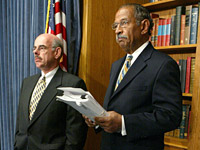Lawyers write memos for many reasonsto bounce ideas around, to elicit criticism and feedback, and to test novel ideas for the first time. What's most striking about these torture memos is their ideological consistency. Almost from the outset the principal ideas were setthat the Geneva Conventions might not apply to some prisoners; that torture could be defined narrowly so as to permit egregious conduct as long as the "intent" was not to violate the law; that conduct prohibited under national and international law could be redefined as permissible. A few critics raised objections along the wayand some of the more questionable practices were eventually halted. But for the most part, these memos reveal a remarkable and uniform willingness up and down the ranks to accept a rather extreme doctrinal and definitional view of torture. They suggest a party line, as opposed to a dialogue. Another striking aspect of the torture memos is the secrecy that surrounded them. We would not know about most of these documents were it not for leaks, Freedom of Information Act requests, and subsequent investigations. There is, to be sure, an urgent need for a national conversation about which interrogation techniques are effective and necessary under exigent circumstances in an age of terror. But these memos reveal what happens when that conversation takes place in secret, within the echo chamber of the administration.
Photograph of John Conyers and Henry Waxman courtesy Getty Images. |
